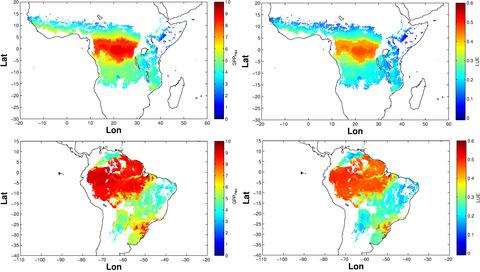当前位置:
X-MOL 学术
›
Glob. Change Biol.
›
论文详情
Our official English website, www.x-mol.net, welcomes your feedback! (Note: you will need to create a separate account there.)
Monitoring tropical forests under a functional perspective with satellite-based vegetation optical depth.
Global Change Biology ( IF 11.6 ) Pub Date : 2020-04-23 , DOI: 10.1111/gcb.15072 Gaia Vaglio Laurin 1 , Cristina Vittucci 2 , Gianluca Tramontana 1, 3 , Paolo Ferrazzoli 2 , Leila Guerriero 2 , Dario Papale 1
Global Change Biology ( IF 11.6 ) Pub Date : 2020-04-23 , DOI: 10.1111/gcb.15072 Gaia Vaglio Laurin 1 , Cristina Vittucci 2 , Gianluca Tramontana 1, 3 , Paolo Ferrazzoli 2 , Leila Guerriero 2 , Dario Papale 1
Affiliation

|
Monitoring ecosystem functions in forests is a priority in a climate change scenario, as climate-induced events may initially alter the functions more than slow-changing attributes, such as biomass. The ecosystem functional properties (EFPs) are quantities that characterize key ecosystem processes. They can be derived by point observations of gas and energy exchanges between the ecosystems and the atmosphere that are collected globally at FLUXNET flux tower sites and upscaled at ecosystem level. The properties here considered describe the ability of ecosystems to optimize the use of resources for carbon uptake. They represent functional forest information, are dependent on environmental drivers, linked to leaf traits and forest structure, and influenced by climate change effects. The ability of vegetation optical depth (VOD) to provide forest functional information is investigated using 2011-2014 satellite data collected by the Soil Moisture and Ocean Salinity mission and using the EFPs as reference dataset. Tropical forests in Africa and South America were analyzed, also according to ecological homogeneous units. VOD jointly with water deficit information explained 93% and 87% of the yearly variability in both flux upscaled maximum gross primary productivity and light use efficiency functional properties, in Africa and South America forests respectively. Maps of the retrieved properties evidenced changes in forest functional responses linked to anomalous climate-induced events during the study period. The findings indicate that VOD can support the flux upscaling process in the tropical range, affected by high uncertainty, and the detection of forest anomalous functional responses. Preliminary temporal analysis of VOD and EFP signals showed fine-grained variability in periodicity, in signal dephasing, and in the strength of the relationships. In selected drier forest types, these satellite data could also support the monitoring of functional dynamics.
中文翻译:

从功能角度利用基于卫星的植被光学深度监测热带森林。
监测森林中的生态系统功能是气候变化情景中的优先事项,因为与气候有关的事件最初对功能的改变可能比诸如生物质等缓慢变化的属性更重要。生态系统功能特性(EFP)是表征关键生态系统过程的数量。它们可以通过对生态系统和大气之间的气体和能量交换进行点观测来得出,这些观测结果是在FLUXNET通量塔站点上全球收集并在生态系统级别进行规模化的。这里考虑的特性描述了生态系统优化碳吸收资源利用的能力。它们代表功能性森林信息,取决于环境驱动因素,与叶片特征和森林结构相关,并受气候变化影响。利用土壤水分和海洋盐分任务收集的2011-2014年卫星数据,并使用EFP作为参考数据集,研究了植被光学深度(VOD)提供森林功能信息的能力。还根据生态均质单位分析了非洲和南美的热带森林。在非洲和南美森林中,VOD与缺水信息共同解释了通量提升的最大初级总生产力和光利用效率功能特性的年度变化的93%和87%。在研究期间,检索到的特性图证明了与气候异常事件相关的森林功能响应的变化。研究结果表明,在高不确定性的影响下,VOD可以支持热带范围内通量的上升过程,以及森林异常功能响应的检测。对VOD和EFP信号的初步时间分析显示出周期性,信号移相和关系强度的细微变化。在选定的较干燥森林类型中,这些卫星数据还可以支持对功能动力学的监视。
更新日期:2020-03-09
中文翻译:

从功能角度利用基于卫星的植被光学深度监测热带森林。
监测森林中的生态系统功能是气候变化情景中的优先事项,因为与气候有关的事件最初对功能的改变可能比诸如生物质等缓慢变化的属性更重要。生态系统功能特性(EFP)是表征关键生态系统过程的数量。它们可以通过对生态系统和大气之间的气体和能量交换进行点观测来得出,这些观测结果是在FLUXNET通量塔站点上全球收集并在生态系统级别进行规模化的。这里考虑的特性描述了生态系统优化碳吸收资源利用的能力。它们代表功能性森林信息,取决于环境驱动因素,与叶片特征和森林结构相关,并受气候变化影响。利用土壤水分和海洋盐分任务收集的2011-2014年卫星数据,并使用EFP作为参考数据集,研究了植被光学深度(VOD)提供森林功能信息的能力。还根据生态均质单位分析了非洲和南美的热带森林。在非洲和南美森林中,VOD与缺水信息共同解释了通量提升的最大初级总生产力和光利用效率功能特性的年度变化的93%和87%。在研究期间,检索到的特性图证明了与气候异常事件相关的森林功能响应的变化。研究结果表明,在高不确定性的影响下,VOD可以支持热带范围内通量的上升过程,以及森林异常功能响应的检测。对VOD和EFP信号的初步时间分析显示出周期性,信号移相和关系强度的细微变化。在选定的较干燥森林类型中,这些卫星数据还可以支持对功能动力学的监视。



























 京公网安备 11010802027423号
京公网安备 11010802027423号